Lower Mainland Southwest BC - Labour Market Bulletin - 3Q05
Lower Mainland Southwest BC
Labour Market Bulletin
3rd Quarter 2005
Contents:
- Employment and Labour Force Trends
- Employment Insurance Claim Trends
- Trends in Key Industries
- Construction
- Trade (Retail and Wholesale) - Youth in the Labour Force
| This bulletin provides information about Lower Mainland Southwest BC employment trends during the third quarter of 2005 (July, August, and September, inclusive). The region is served by the Human Resource Centres of Canada based in Abbotsford, Burnaby, Coquitlam, North Vancouver, Surrey and Vancouver. |
Employment and Labour Force Trends
The employment picture continues to be positive in the Lower Mainland Southwest. According to the Labour Force Survey (LFS) by Statistics Canada, 31,000 full-time jobs were added and just over 5,000 part-time jobs were lost over the third quarter, bringing the net gain to 26,000 jobs, a 2% increase over the same period last year.
The upward trend continues to be driven by Construction, which added 13,700 jobs this quarter, almost all of them full-time. This was exceeded by Business, Building and Other Support Services, an industry which has a large employee base in building management and benefits directly from construction growth. This industry added 14,600 new jobs, over 92% of them full-time.

Although construction tends to have the spotlight, positive growth was also reported for other significant industries:
- Trade, which has the largest employee base of all Southwest BC industries, added 10,300 new jobs, and over 90% of these were full-time.
- Although nearly two-thirds of Education workers are employed full-time, over 67% of new jobs in Education this quarter were part-time. The growth appears to be occurring mainly at the post-secondary level and in English as a Second Language (ESL) training.
- Employment continues to grow in Transportation and Warehousing, largely because of increased business and expansion at the Lower Mainland Southwest port terminals. This quarter, 8,300 jobs were added and 99% of these were full-time.
- Forestry, Fishing, Mining, and Oil and Gas has a small employee base relative to other industries in the Lower Mainland Southwest, but resource-based industries continue to be significant contributors to BC's GDP. Although the LFS reported job growth of just over 60% (or 3,500 new jobs), the employment picture wasn't rosy across the board. Falling lumber prices and the ongoing softwood lumber dispute continued to hamper Forestry, and the west coast salmon fishery experienced a severe setback this year. Most of the job growth this quarter occurred in Mining and Oil and Gas. The future for skilled, well-paid work looks positive particularly for Oil and Gas, as well as Mining. According to an industry report titled The Decade Ahead by the Petroleum Human Resources Council of Canada
 , 7,000 new jobs will be added on a Canada-wide basis over the next few years. The majority of these jobs will be for heavy equipment and process operators, and mechanics. Engineers, electricians and technicians should be in demand too. It's clear from the report that worker mobility will be key to working successfully in this industry. For information on mining opportunities, see Prospecting the Future: Meeting human resource challenges
, 7,000 new jobs will be added on a Canada-wide basis over the next few years. The majority of these jobs will be for heavy equipment and process operators, and mechanics. Engineers, electricians and technicians should be in demand too. It's clear from the report that worker mobility will be key to working successfully in this industry. For information on mining opportunities, see Prospecting the Future: Meeting human resource challenges  , on the BC Mining Association web site.
, on the BC Mining Association web site.
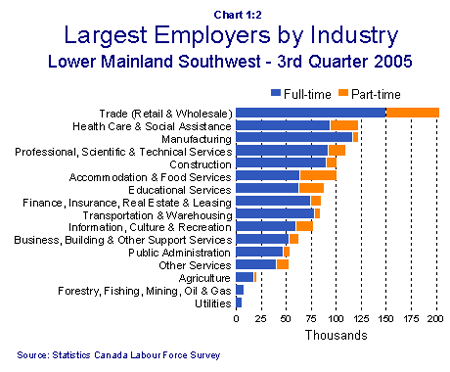
Although more job gains than losses were reported this quarter, notable employment declines were seen in industries that tend to be large employers:
- Accommodation and Food, which employs over 100,000 workers in the Lower Mainland Southwest, lost 3,000 jobs this quarter. Over two-thirds of all employment in this industry is part-time, so that is not good news, particularly for students who depend on flexible hours and access to evening and weekend work.
- Health Care and Social Assistance gained 700 full-time jobs, but lost 7,100 part-time jobs. Although medical workers (for example: registered nurses, doctors, lab technicians and technologists) are in demand, the labour situation continues to be volatile, particularly for non-medical Health Care workers. On the Social Assistance side, a new daycare deal was signed on September 30th between the provincial and federal governments. This may result in expanded employment opportunities, but there are no hard numbers at this stage.
- Manufacturing continued to lose both full-time (-700) and part-time (-2,100) jobs. The higher Canadian dollar has reduced the US demand for exports, causing some employers to cut back staff. The truckers' dispute in July delayed the distribution of goods, and this may also have lead to staff reductions.
- Finance, Insurance, Real Estate and Leasing employed 85,700 workers over the third quarter. Although reports indicate business is booming in all of these areas, particularly Real Estate which is tied to the prosperous housing market, the LFS reported job losses totaling 10,700. Just over half of these were full-time.
Unemployment rates fell year over year for all but the oldest working-age groups this quarter. Although 15-19 year olds continued to have the highest unemployment rate, they experienced the most dramatic decline, falling to a rate of 13.4% in the third quarter of 2005 from nearly 21% during the same period last year. Looking at third quarter results over the past ten years, 2005 represents the lowest rate this group has experienced at least since 1996. A more detailed report on youth in the labour force is included in this bulletin.
| 2003 | 2004 | 2005 | |
|---|---|---|---|
| All ages | 8.4% | 6.9% | 6.0% |
| 15-19 | 26.3% | 20.6% | 13.4% |
| 20-24 | 10.5% | 10.7% | 8.6% |
| 25-44 | 7.2% | 5.7% | 4.8% |
| 45-64 | 6.1% | 5.3% | 5.8% |
Employment Insurance Claim Trends
The rapidly improving economy in the Lower Mainland Southwest is creating sufficient job opportunities to significantly reduce the number of individuals on Employment Insurance (EI).
Work-ready EI claims totalled 30,400 in the third quarter of 2005 - the lowest level in the past four years and a drop of nearly 7,000 claims from the same period a year ago.
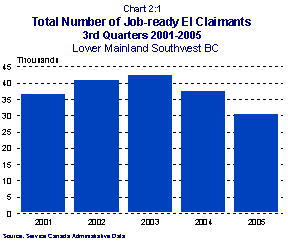
Although claims declined over each of the past two years, the steepest drop (more than 18 percent) occurred between 2004 and 2005.
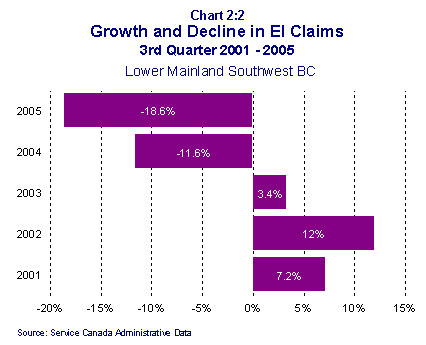
The third quarter trend among the ten largest EI claimant groups by occupation over the past year mirrors that for overall claims, with declines in the range of one to 33 percent. As indicated in the table below, this category characteristically consists of the lower-skilled occupations, with the exception of secretaries and cooks.
| Third Quarter | |||
|---|---|---|---|
| 2004 | 2005 | % Change | |
| 9617 Labourers in Food, Bev & Tobacco Procg | 757 | 505 | -33.3% |
| 6242 Cooks | 762 | 601 | -21.1% |
| 6421 Retail Salespersons and Sales Clerks | 921 | 749 | -18.7% |
| 1411 Gen Office Clerks | 780 | 641 | -17.8% |
| 8431/8611 Gen Farm Workers/Harvest Labourers | 733 | 628 | -14.3% |
| 1241 Secretaries (Except Legal & Medical) | 637 | 546 | -14.3% |
| 7611 Constr Trades Helpers and Labourers | 810 | 708 | -12.6% |
| 9619 Oth Labourers in Proc, Mfg & Utils | 789 | 724 | -8.2% |
| 6472 Elem & Sec School Teacher Assistants | 1747 | 1649 | -5.6% |
| 7452 Material Handlers | 515 | 507 | -1.6% |
The largest group in the current quarter was Teacher Assistants, whose numbers tend to surge in September as their seasonal claims are processed. While Food and Beverage Manufacturing Labourers saw the greatest change year over year, Construction Labourers have experienced the sharpest drop in claims over the past few years as the housing boom absorbed lesser-skilled workers. Their claims accordingly have fallen from 1,835 in 2001 to the current 708.
Trends in Key Industries
Construction
Construction is a key economic driver in the Lower Mainland Southwest. Although housing construction is predicted to continue booming, the BC Construction Sector Council  predicts there will be even more jobs in non-residential construction over the next eight years. Occupations that the Council predicts will see job growth include Boilermakers (+18%), Millwright and Industrial Mechanics (+16%), Ironworkers (+9%), and Refrigeration and Air-Conditioning Mechanics (+6%).
predicts there will be even more jobs in non-residential construction over the next eight years. Occupations that the Council predicts will see job growth include Boilermakers (+18%), Millwright and Industrial Mechanics (+16%), Ironworkers (+9%), and Refrigeration and Air-Conditioning Mechanics (+6%).
The non-residential sector includes industrial buildings, such as mines and mills used for manufacturing and processing; and commercial buildings like retail stores and warehouses, as well as hotels and institutional and government buildings. Statistics Canada recently reported that between the first and second quarters in 2005, BC cities posted some of the biggest percentage increases in non-residential construction; among them Abbotsford, which reported a 78.3% increase, and Vancouver, which reported 19.3%.
According to the Vancouver Regional Construction Association  , $72 billion in projects are planned between now and the year 2012. Notable projects planned or underway in the Lower Mainland Southwest include:
, $72 billion in projects are planned between now and the year 2012. Notable projects planned or underway in the Lower Mainland Southwest include:
- $3.9 billion regional road and transit improvements
- the Province's planned $3-billion Gateway Program of additional road and bridge projects, including the $1.7-billion RAV line
- the $1.4-billion expansion of the Vancouver International Airport
- Vancouver Port and Deltaport expansions
- $700 million in 2010 Olympics construction
- $600 million worth of facilities for the University of British Columbia
Industry associations continue to warn of looming skills shortages as demand for skilled labourers outpaces supply. Alberta is also in a high cycle of construction activity, and this may attract workers from BC, especially if it can offer a lower cost of living and the potential for greater income.
Although Employment Insurance (EI) claims for construction trade labourers still number in the hundreds in the Lower Mainland Southwest, they continue to decline. This is a direct result of the job creation that is occurring in building construction. Overall, the number of skilled trade workers claims is nearly half of what they were in 2002.
| Occupation | 3Q2005 | 3Q2004 | % change |
|---|---|---|---|
| 7611 Construction Trades Helpers and Labourers | 708 | 810 | -12.6% |
| 7271 Carpenters | 280 | 308 | -9.1% |
| 7265 Welders | 230 | 274 | -16.1% |
Construction Trade Helpers and Labourers (NOC 7611) 
Work Futures British Columbia provides a comprehensive description  of this occupation, but readers may also want to review the profile
of this occupation, but readers may also want to review the profile  on the US Department of Labour site, as it also contains useful information about working conditions and the type of work labourers do.
on the US Department of Labour site, as it also contains useful information about working conditions and the type of work labourers do.
Although this occupation is classified in Canada at a lower skill level and most workers are informally trained on-the-job, employers are seeking people who have at least grade 12 and the capability for higher learning. This occupation can be an excellent starting point for those considering moving into a higher skilled trade area or apprenticeship.
Lower Mainland construction employers foresee substantial growth leading up to the 2010 Olympics and this bodes well for all trades workers, including labourers. In addition, many labourers are nearing retirement and will need to be replaced. The average age of Southwest BC EI claimants in this occupation is 39 years.
According to the Canadian Occupational Projection System (COPS), this occupation is expected to grow at a rate slightly above the average for all occupations between 2003 and 2013. The forecast calls for approximately 5,000 additional jobs over this period. Of these, about 2,900 will be new, and just over 2,100 may result because of retirements.
This is a very large occupational group which has a significant amount of turnover. Large numbers of labourers are needed each year to replace those who leave the occupation. The Lower Mainland Southwest area accounts for over 54% of the provincial labour force.
Carpenters (NOC 7271) 
In BC, apprenticeship for carpenters is not compulsory, but it is a common requirement. Carpentry apprenticeship consists of on-the-job training and six weeks of classroom instruction per year. A BC program called Secondary School Apprenticeship enables high school students to move directly into the apprenticeship training system while they are in school. Students are able to register as young as 15 years of age and can start accumulating credits toward both apprenticeship and high school graduation. This program is administered by the Industry Training Authority of British Columbia  .
.
According to COPS, this occupation is forecast to have above-average growth between 2003 and 2013. Approximately 20,800 people are employed as carpenters in BC and 45% work in the Lower Mainland. At the time of the 2001 Census, nearly 40% of all BC carpenters were over the age of 45, which means they are about 50 or older today.
Employers report that they are having difficulty finding qualified and experienced carpenters. There is a higher demand for those with high skill levels. Apprentice carpenters are generally chosen from a company's current employees, such as construction labourers. Carpenters usually find work through direct contact with employers, although some hiring is done through union hiring halls.
For an occupational description see BC Work Futures  and the profile
and the profile  on the US Department of Labour site.
on the US Department of Labour site.
Welders (NOC 7265) 
Welding is a relatively small occupation in BC. At the time of the 2001 Census, BC employed about 8,000 welders, and 77% of these were in the Lower Mainland Southwest. The average age of welders, at the time of the Census, was 40 years and over one-third of all welders were over the age of 45. Although the COPS forecast for welders is for below-average growth to 2013, industry sources expect the looming retirements will increase opportunities for work over the next 10 years.
The majority of welders work in manufacturing and construction, but increasing activity in the Oil and Gas industry in BC and Alberta is creating opportunities for welders.
Experienced welders may advance to positions such as welding inspector, welding foreman or supervisor, or plant supervisor. Welders may transfer their skills to occupations such as steamfitter, pipefitter, ironworker, or boilermaker.
For an occupational description see BC Work Futures  and the profile
and the profile  on the US Department of Labour site.
on the US Department of Labour site.
Construction Websites
- BC Work Futures for Trades and Technical Occupations

- British Columbia Construction Association

- Vancouver Regional Construction Association

- Careers in Construction

- Construction and Specialized Workers' Union Local 1611

- The British Columbia Safety Council

- The Workers Compensation Board of British Columbia

- Oil and Gas Jobs

Trade (Retail and Wholesale)
With over 200,000 workers, Trade is the largest employer in the Lower Mainland Southwest. Three quarters of workers are in Retail and the remainder work in Wholesale. This sizeable industry is showing signs of a rebound. Employment grew by 3.1% over the past quarter and since the third quarter a year ago has risen by an even greater 5.3%, adding more than 10,000 workers.
Retail is heavily dependent on part-time employees (particularly young students). The employment gains in Trade over the past year, however, went primarily to full-time work, which rose by 6.7% compared with a part-time rise of 1.7%.

Retail is also a seasonal industry in which employers tend to staff up in the second half of the year and cut back during the post-Christmas doldrums. The rising popularity of gift cards, however, is helping to prolong employment into January.
Trade EI claims averaged 1,439 during the third quarter, a decline of 14.6% from the same period a year ago. Retail Salespersons and Clerks are by far the largest claimant group in Trade, as shown in the graph below. The significant decline in overall Trade claims since 2003 reflects mainly the trend for this group as well as for Wholesale Trade Representatives. Claims for third quarter Retail Trade Managers, on the other hand, have regained the level previously seen in 2000.

The recent turnaround in regional Trade employment reflects a booming economy and housing market. Both retail and wholesale sales in the province bucked the national trend in August, with monthly gains of 2.3% and 3.0% respectively. This buoyant spending was fuelled by historically low interest rates, ongoing population growth, and rising job levels and incomes. Home-related big-box building suppliers, and electronics, appliances and furniture retailers have been particular beneficiaries of this year's shopping spree.
Companies which have recently added or refurbished stores in the Lower Mainland include Canadian Tire, Best Buy, and its subsidiary, Future Shop. Best Buy and Future Shop recently announced plans to hire nearly 1,300 additional sales associates in the province (40 to 50 per store) to handle the Christmas rush for electronic equipment. Shoppers Drug Mart is also opening a new store this fall on the University of British Columbia campus. Other expanding businesses include Costco, organic grocers (Capers, Whole Foods, and Choices), M&M Meat Shops in partnership with Mac's Milk, and online retailers.
How long this will last is unclear. Consumer confidence levels in BC dropped sharply in August (the first decline in three years); the strong home furnishing sector is facing higher competition from recent expansions; and there is evidence that retail sales are now growing more rapidly outside the Vancouver metropolitan area. Rising interest rates on credit cards and high prices for gasoline and winter home heating fuel will leave heavily indebted consumers with less disposable income, a scenario which could begin to dampen Retail Trade sales and employment next year.
Youth in the Labour Force
Youth tend to have higher unemployment rates than adults because they have less education and experience. Although older youth have a broader range of opportunity in the labour market, young people, overall, tend to be employed in lower-paying, lower-skill service jobs that offer little stability. In the Greater Vancouver Regional District (GVRD), two-thirds of youth aged 15 to 19 were in sales and service jobs at the time of the last Census (2001). The same occupational group employed over 31% of youth aged 20 to 29. On a positive note, many of these jobs offer greater flexibility in terms of work hours and shifts - which is practical for students - and there are more of them available. Trade (comprising mostly retail, but also wholesale) for example, employed over 180,000 workers in 2004, making it the single largest employer in the Lower Mainland. (The next largest industry for employment was Manufacturing, with 107,000 workers). Industries that have a large employee base can offer many more job prospects.
Distribution of Youth
The 21 municipalities that make up Greater Vancouver  account for 94% of the Lower Mainland Southwest BC youth population. In 2005, 27% are 15-19 years, 34% are 20-24 years, and 40% are 25-29 years. Outside the GVRD, in the more rural Southwest BC communities (Abbotsford, Chilliwack, Hope, Mission, and the Sunshine Coast), 15-19 year olds make up 36% of the youth population, while 20-24 year olds and 25-29 year olds account for 34% and 30%, respectively. This reflects a couple of trends. As real estate prices increase across the Lower Mainland, more families are living farther out. Older youth, however, are likely to move into the urban areas to complete their post-secondary education and to work.
account for 94% of the Lower Mainland Southwest BC youth population. In 2005, 27% are 15-19 years, 34% are 20-24 years, and 40% are 25-29 years. Outside the GVRD, in the more rural Southwest BC communities (Abbotsford, Chilliwack, Hope, Mission, and the Sunshine Coast), 15-19 year olds make up 36% of the youth population, while 20-24 year olds and 25-29 year olds account for 34% and 30%, respectively. This reflects a couple of trends. As real estate prices increase across the Lower Mainland, more families are living farther out. Older youth, however, are likely to move into the urban areas to complete their post-secondary education and to work.
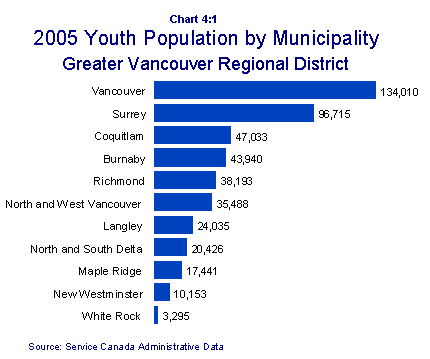
In 2005, the City of Vancouver has 28.5% of the total GVRD youth population, followed by Surrey, which has 20.5%. Beyond these proportionally large areas, the breakdown is as follows:
- Coquitlam 10.0%
- Burnaby 9.3%
- Richmond 8.1%
- North & West Vancouver 7.5%
- Langley 5.1%
- North & South Delta 4.3%
- Maple Ridge 3.7%
- New West 2.2%
- White Rock 0.7%
Occupations of Youth
There are significant differences in the occupations held by 15-19 year olds and those held by older youth, 20 to 29. For example, although sales and service occupations were dominant for both age groups in 2001, 15 to 19 year olds had a much greater representation in these occupations and far less occupational variety and opportunity than their older cohorts.
15-19 age group:
In 2001, 47,310 youth aged 15-19 years were in the GVRD labour force, accounting for nearly a fifth of the total youth labour force and 4.5% of the total labour force. They had very little representation in other occupational classifications and virtually all of the occupations they worked in were at the lowest skill and wage levels. Two-thirds (31,285) were employed in elementary sales and services occupations.
Business, finance, and administration employed 11.5% (5,425). Eighty-nine percent of those were employed in low level clerical jobs.

The top occupations for 15-19 year olds at the time of the Census were:
- Food counter attendants and kitchen helpers
- Retail sales clerks
- Cashiers
- Food and beverage servers
- Grocery clerks and store shelf stockers
- Cooks
- Program leaders and instructors in recreation and sport
- Babysitters, nannies and parents' helpers
- Material handlers
- Maître d'hôtel and hosts/hostesses
- General office clerks
- Receptionists and switchboard operators
- Landscaping and grounds maintenance labourers
- Customer service, information and related clerks
- Janitors, caretakers and building superintendents
- Couriers, messengers and door-to-door distributors
- Food service supervisors
- Delivery and courier service drivers
- Service station attendants
20-29 age group:
According to the last Census, 194,440 youth aged 20-29 years were in the GVRD labour force in 2001, accounting for over 80% of the total youth labour force and almost 20% of the total labour force. As the graph below shows, older youth had a greater representation across occupational classifications than did 15-19 year olds. What's more, although older youth were employed in lower skill occupations, a greater percent were also employed in higher skill level occupations.
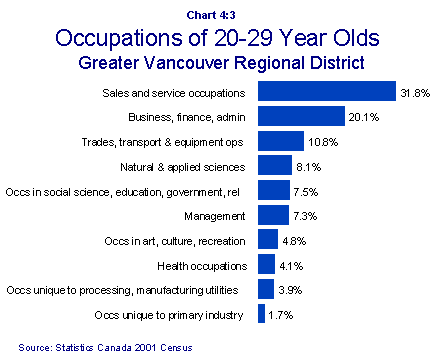
Sales and service topped the list of occupational groups for those aged 20-29 but it accounted for slightly less than a third of all older youth employment, compared with two-thirds for 15-19 year olds. Older youth had nearly twice the representation of their younger cohorts in business, finance and administration. And, while 15-19 year olds had almost no opportunity to work in trades, transport and equipment operating, this classification accounted for nearly 11% of employment for 20-29 year olds in 2001.
The top occupations for 20-29 year olds at the time of the Census were:
- Retail salespersons and sales clerks
- Food and beverage servers
- General office clerks
- Computer and information systems professionals
- Finance and insurance clerks
- Cashiers
- Paralegals, social services workers and occupations in education and religion
- Auditors, accountants and investment professionals
- Managers in retail trade
- Library, correspondence, and related information clerks
- Chefs and cooks
- Motor vehicle and transit drivers
- Secondary and elementary school teachers and educational counsellors
- Child care and home support workers
- Longshore workers and material handlers
- Travel counsellors
- Secretaries, recorders and transcriptionists
- Cleaners
- Managers in food service and accommodation
- Assisting occupations in support of health services
Note: In preparing this bulletin, Service Canada has taken care to provide clients with labour market information from reliable sources that is timely and accurate at the time of publication. Since labour market conditions are dynamic, some of the information presented here may have changed since this bulletin was published. Readers are encouraged to also refer to other sources for additional information on the local economy and labour market. Information contained in this bulletin does not necessarily reflect official policies of Service Canada.
To locate the local SCC offices in the Lower Mainland Southwest BC area please use the links below:
Vancouver - North Shore - Burnaby - North Fraser/Coquitlam - Surrey - Abbotsford.


